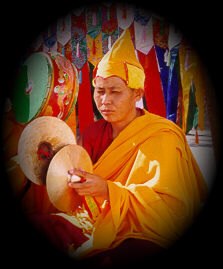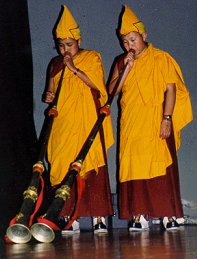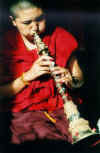| Nuns of Khachoe Ghakyil Women's Freedom and Spiritual Liberation: 2000 European Tour |
| Ritual music | Training the nuns in Buddhist philosophy and debate is not the only innovation at KGN. The nuns are now receiving education in the full range of ritual arts, including music, sacred dance, and sand mandala painting. All of these ritual arts are integral parts of the meditative practices that Tibetans have been performing since the beginning of Tibetan monasticism in the ninth century. |
| The KGN nuns' performances all include music (voice and/or instruments), and two pieces in particular - The Practice of Chöd and The Dance of the Dakinis - have especially elaborate musical accompaniment. In these, the nuns will play the following traditional Tibetan temple instruments: | |
drilbu (bell) |
The drilbu
or hand bell is always played in the left hand at heart level. It is held at the
middle of the handle (rather than the end) and swung back and forth on its fulcrum.
The sound of the bell reminds the meditator of the inherent emptiness of all things, and
the enlightened quality of wisdom one must develop to attain this realization. You
will see the dancers playing these during the Dance of the Dakinis (Khandro Rolyang)
along with the small damaru or hand drum. Click here to hear a RealAudio sample of the nuns playing drilbus (from the CD The Bliss Whirl of the Sky Dancers). You will also hear other nuns playing gyalings (see below), a large drum, and cymbals. |
small damaru |
The damaru or two-sided hand drum is played in the right hand by rotating it from side to side - the two pellets or "strikers" hit both sides of the drum simultaneously as they move in opposite directions. The sound reminds the meditator of the union of wisdom and compassion. |
Chöd damaru |
There are, in fact,
two kinds of damarus. The kind used in most practice is roughly the size of one's
palm, and has either a diamond-shaped or round surface. The larger Chöd
damaru is played when performing Chöd (cutting attachment) practice, always has
a circular shape, and has a much deeper tone. In either case, the sound recalls the
union of compassion and wisdom. Click here to hear a short RealAudio sample of the nuns playing the Chöd damaru in unison (from the CD The Bliss Whirl of the Sky Dancers). |
| Kangling is the
Tibetan word for a trumpet or horn made out of a human thighbone. (It may also be
made out of wood or metal.) In Chöd practice the practitioner, motivated by
compassion, plays the kangling to summon hungry spirits and demons so that s/he
may satisfy their hunger and thereby relieve their sufferings. The drilbu is also
played at certain points in the Chöd practice. Click here to hear a RealAudio sample of the unearthly sound of the kangling (from the nuns' new CD, The Bliss Whirl of the Sky Dancers). |
|
 |
Silnyen is
the Tibetan word for cymbals, which are held in the hands and played in pairs. There are two kinds of cymbals: the flat ones (see at left) which are held vertically and are played for peaceful practice, and the rounded ones (called rolmo) which are used in wrathful (energetic) practice and are held horizontally. Cymbals are generally played to a beat, to give percussive rhythm to a chant; but they are also played in a series of clashes and accelerating rolls, usually at the end of an offering or prayer. In this latter context, they symbolize the offering of pure music (Skt. shabda) to enlightened beings. Click here to hear a RealAudio sample of Tibetan cymbals. |
| Dungchen means great horn
in Tibetan. This horn - similar in appearance to the long horn of the Swiss Alps - produces the memorably earth-shaking bass tones for which Tibetan ritual music is especially famous. Click here to hear a RealAudio sample of a dungchen. The dungchen can be telescoped so that it can be carried in compact form (watch the nuns on stage as they expand, then collapse, the two dungchens!). However, at its full length it can be up to 15 feet in length. Dungchens are frequently played in processions, as is ... |
 |
 |
The gyaling
is an uncapped double-reeded instrument, or shawm, similar in construction to the
oboe. It is not used to create "melodies" in the western sense.
Rather, it is played within a range of four or five high-pitched tones in a series of
stirring vibrato flourishes. Gyalings sound a little like trumpets. Click here to hear a RealAudio sample of the nuns playing gyalings (from the CD The Bliss Whirl of the Sky Dancers). You will also hear other nuns playing drilbus (bells), a large drum, and cymbals. |
Don't have RealAudio? Go to the RealPlayer site and download RealPlayer 8 Basic for free!
|
Sacred
performance | Ritual music | Sand
mandalas | The nuns of KGN | Image
gallery
CD recording | European tour itinerary
(in German) | Info for organizers | Support the nuns! | Related links
© Khachoe Ghakyil 1999-2002
Web custodian Julia Milton
Hosted by Women Active in Buddhism.